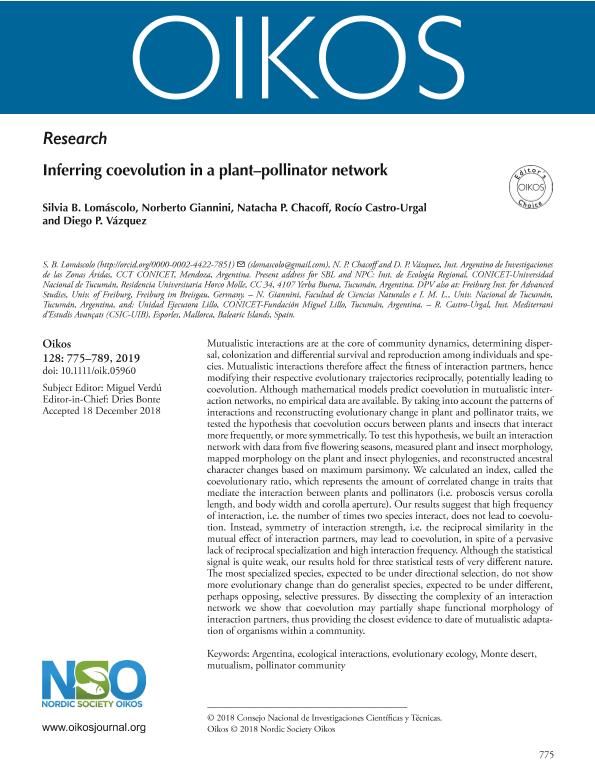Artículo
Inferring coevolution in a plant–pollinator network
Lomascolo, Silvia Beatriz ; Giannini, Norberto Pedro
; Giannini, Norberto Pedro ; Chacoff, Natacha Paola
; Chacoff, Natacha Paola ; Castro Urgal, Rocío; Vazquez, Diego P.
; Castro Urgal, Rocío; Vazquez, Diego P.
 ; Giannini, Norberto Pedro
; Giannini, Norberto Pedro ; Chacoff, Natacha Paola
; Chacoff, Natacha Paola ; Castro Urgal, Rocío; Vazquez, Diego P.
; Castro Urgal, Rocío; Vazquez, Diego P.
Fecha de publicación:
12/2018
Editorial:
Wiley Blackwell Publishing, Inc
Revista:
Oikos
ISSN:
0030-1299
Idioma:
Inglés
Tipo de recurso:
Artículo publicado
Clasificación temática:
Resumen
Mutualistic interactions are at the core of community dynamics, determining dispersal, colonization and differential survival and reproduction among individuals and species. Mutualistic interactions therefore affect the fitness of interaction partners, hence modifying their respective evolutionary trajectories reciprocally, potentially leading to coevolution. Although mathematical models predict coevolution in mutualistic interaction networks, no empirical data are available. By taking into account the patterns of interactions and reconstructing evolutionary change in plant and pollinator traits, we tested the hypothesis that coevolution occurs between plants and insects that interact more frequently, or more symmetrically. To test this hypothesis, we built an interaction network with data from five flowering seasons, measured plant and insect morphology, mapped morphology on the plant and insect phylogenies, and reconstructed ancestral character changes based on maximum parsimony. We calculated an index, called the coevolutionary ratio, which represents the amount of correlated change in traits that mediate the interaction between plants and pollinators (i.e. proboscis versus corolla length, and body width and corolla aperture). Our results suggest that high frequency of interaction, i.e. the number of times two species interact, does not lead to coevolution. Instead, symmetry of interaction strength, i.e. the reciprocal similarity in the mutual effect of interaction partners, may lead to coevolution, in spite of a pervasive lack of reciprocal specialization and high interaction frequency. Although the statistical signal is quite weak, our results hold for three statistical tests of very different nature. The most specialized species, expected to be under directional selection, do not show more evolutionary change than do generalist species, expected to be under different, perhaps opposing, selective pressures. By dissecting the complexity of an interaction network we show that coevolution may partially shape functional morphology of interaction partners, thus providing the closest evidence to date of mutualistic adaptation of organisms within a community.
Archivos asociados
Licencia
Identificadores
Colecciones
Articulos(IADIZA)
Articulos de INST. ARG DE INVEST. DE LAS ZONAS ARIDAS
Articulos de INST. ARG DE INVEST. DE LAS ZONAS ARIDAS
Articulos(IER)
Articulos de INSTITUTO DE ECOLOGIA REGIONAL
Articulos de INSTITUTO DE ECOLOGIA REGIONAL
Articulos(UEL)
Articulos de UNIDAD EJECUTORA LILLO
Articulos de UNIDAD EJECUTORA LILLO
Citación
Lomascolo, Silvia Beatriz; Giannini, Norberto Pedro; Chacoff, Natacha Paola; Castro Urgal, Rocío; Vazquez, Diego P.; Inferring coevolution in a plant–pollinator network; Wiley Blackwell Publishing, Inc; Oikos; 128; 6; 12-2018; 775-789
Compartir
Altmétricas



